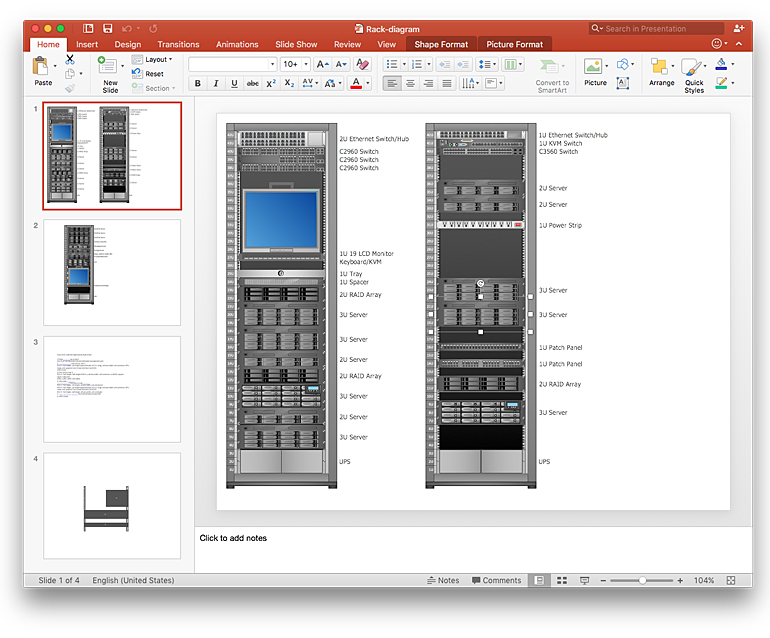HelpDesk
How to Add a Rack Diagram to a PowerPoint Presentation Using ConceptDraw PRO
Rack diagrams are created to make short work of configuring and documenting the server and network equipment of the rack frameworks. Rack diagrams may be useful when considering equipment purchasing, or installing. Using the ConceptDraw Rack Diagrams solution, you can quickly and easily design a rack diagram from the set of vector graphic objects that are fully consistent with accepted industry standards. The Rack diagram will help you when considering and purchasing a rack of network equipment. When installing equipment, a rack diagram will help you to situate equipment quickly and in a due manner. The PowerPoint presentation on concept of your server room rack layouts can be very informative and helpful. ConceptDraw PRO allows you to easily create wireless network diagrams and then make a PowerPoint Presentation from your diagrams in a single click.Design Element: Rack Diagram for Network Diagrams
ConceptDraw PRO is perfect for software designers and software developers who need to draw Rack Diagrams.
 Computer Network Diagrams
Computer Network Diagrams
Computer Network Diagrams solution extends ConceptDraw PRO software with samples, templates and libraries of vector icons and objects of computer network devices and network components to help you create professional-looking Computer Network Diagrams, to plan simple home networks and complex computer network configurations for large buildings, to represent their schemes in a comprehensible graphical view, to document computer networks configurations, to depict the interactions between network's components, the used protocols and topologies, to represent physical and logical network structures, to compare visually different topologies and to depict their combinations, to represent in details the network structure with help of schemes, to study and analyze the network configurations, to communicate effectively to engineers, stakeholders and end-users, to track network working and troubleshoot, if necessary.
- Design elements - Rack diagram | Measurement Of 1u Rack Cabinets
- 1u Rack Dimensions
- 19 Rack Panel Dimensions
- Rack Dimensions 1u
- 1u Rack Mount Svg
- Server Rack Cabinet Vector
- Rack units | Rack Diagrams | Design elements - Rack diagram ...
- Rack 19 Panel
- Rack Unit Dimensions
- Half Rack Size
- Design elements - Rack diagram | Rack diagrams - Vector stencils ...
- Rack diagrams - Vector stencils library | Server 1u Svg
- What Is The Industry Standard For Rack Height In Rack Units
- Panel Over Server Rack
- How To use Switches in Network Diagram | Rack diagram ...
- Computer Rack Dimensions
- Rack units | Rack diagram - Template | Design elements - Rack ...
- Rack diagram - Template | Volleyball court dimensions | Rack ...
- Rack Unit Template

.png)